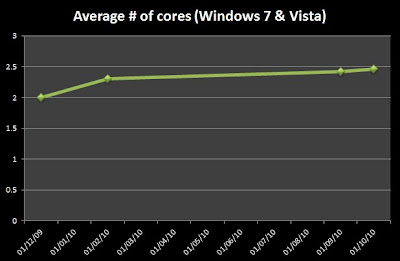The cores are still coming - and IE9 is still faster


Multicore is already mainstream and four cores are selling fast. IE9 platform preview 6 is here and it's still beating the other browsers on speed tests.
Over the last year, the IE team have been telling us that it's worth them building a JavaScript compiler that runs on the second core of a multicore system in the background, taking over from the interpreter on the main core as soon as possible - because everyone has a second core.
That's based on the average CPU reported by the Windows Experience Index score on all the Vista and Windows 7 PCs that run the performance test. And I noticed something watching Jason Weber show off how the latest IE9 platform preview is still faster than the nightly builds of Firefox and Chrome - which answers some of the criticisms about the IE team cherrypicking which browsers to compare.
The latest Chrome 8 nightly with the default hardware acceleration enabled runs the Speed Read test at a third of the IE9 speed (20fps compared to 60fps); IE9 finishes the test in 14 seconds, Chrome took around six minutes to run on the same PC and at 3fps Safari actually takes around 18 hours to finish the test.
On the Pacman-style Browser Hunt test that IE9 was running at 60fps thanks to its GPU-accelerated canvas, the Chrome 9 build from 7.30 this morning only managed 38 to 45fps for example, and the latest Firefox 4 beta 6 nightly build flew the SVG helicopter at 18mh rather than 180mph, with the movement looking very jerky - although the average is 17fps, it was taking anywhere between 34 and 88 milliseconds to draw a frame. Firefox shows the same variance in times in the fish tank test; the variation in how long Firefox takes t do a call back is two or three times more than the variance from IE, so again your experience isn't as smooth - which could get frustrating in a complex Web app.
Some of the difference is the way IE9 accelerates everything on the page, like the video background in the Track Splash test (Chrome Canary did a nice job of drawing the canvas elements but couldn't render the video and still took six times longer than IE9). There's the speed up from the JavaScript being inside the browser so you're not waiting for the marshalling system to send stuff back and forth over COM, and there's the speedup from JavaScript being compiled on your second core.
When the IE team first showed us the architecture of the Chakra JavaScript engine, I wondered if putting JavaScript on the second core would be competing with the other things that Windows is already running on my second core. That's not a problem if you have four cores, and the figures from the Windows Experience Index say that's getting more common.
On February 1st this year, the average number of cores was 2.3 (up from 2 in December 2009). By September that was up to 2.42 cores and the average core number on October 1st was 2.46 cores. With all the single-core Atom netbooks pulling down the average, there's still a lot of four cores and more on the way.
Mary Branscombe
